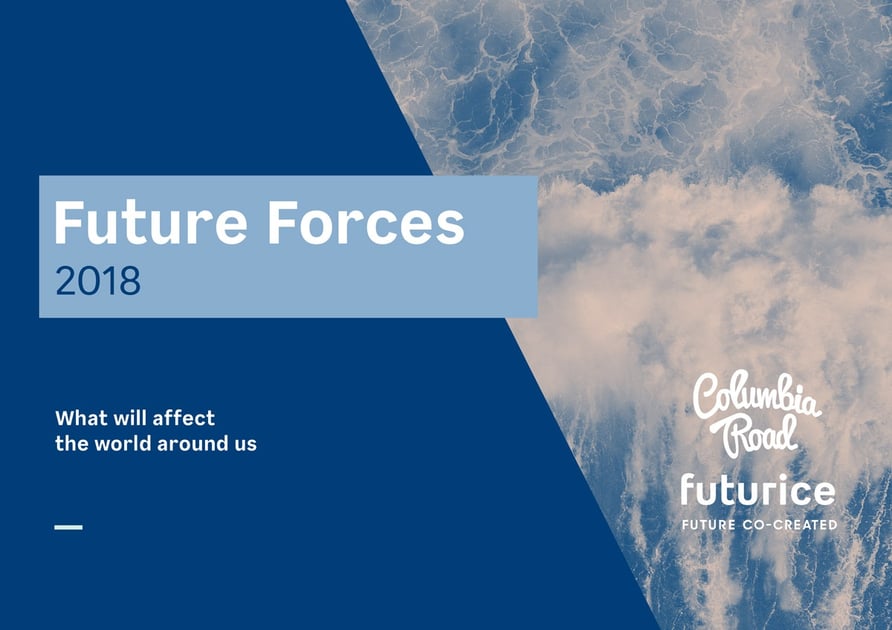The Data Handbook
How to use data to improve your customer journey and get better business outcomes in digital sales. Interviews, use cases, and deep-dives.
Get the book Emerging technologies are giving us unlimited opportunities to create the future differently. Thinking the unthinkable is no longer optional, it’s mandatory.
Emerging technologies are giving us unlimited opportunities to create the future differently. Thinking the unthinkable is no longer optional, it’s mandatory.
This means challenging ourselves to move beyond our comfort zones, whether that’s operating outside familiar industry and sector boundaries or making friends with our enemies. The future is about finding and capturing new value through disruptive ecosystems based on unexpected partnerships.
Asking the right questions and debating the right answers helps to deepen our understanding of what’s possible. Future Forces is Futurice Group's way to help envision different opportunities and outcomes in a fast shifting environment when our very way of existing is being disrupted.
Three key techno-societal shifts form the backdrop for Future Forces, influencing and shaping the trends we have identified. The first is Exo Human, the cloud of data that accompanies our every digital move, tap, message and thought and which will eventually help us manage our human lives for the better.
The second shift is the Increased Innovation at the Edges of traditional sectors which is blurring the distinction between companies and industries. The third shift, Artificial Intelligence, powers the other two, automating activity and driving innovation.
This year we have again explored Future Forces by sector, although, the rapid blurring of boundaries has given rise to two cross industry themes. Decentralisation - where decision-making is moving from governments and big corporation to empowered communities - is influencing sectors including finance – in the form of cryptocurrencies, energy - the rise of micro-grids – and work where freelancers/solopreneurs and the gig economy are dominating the political and media agenda. As we’ve seen in the reaction to Uber’s woes, Values and Purpose is another key theme, a possible backlash to relentless technological innovation and instant gratification.
Here are key highlights of Future Forces by sector
Energy
Mighty Microgrids
More efficient battery storage technology means that community-driven decentralised energy microgrids are now a real possibility, with groups of homes and businesses banding together in ever-smarter grids with demand response capabilities.
The Brooklyn Microgrid is a virtual peer-to-peer trading platform that allows solar-energy producers to sell their excess electricity to buyers in the same neighbourhood. Meanwhile China’s Solar Roadway project harnesses the energy generated by passing vehicles to power local energy needs.
Across the world, these new communities are likely to be socially and economically strengthened by their focus on energy-sharing.
Bio Benefits
The localisation of energy sources is mirrored by the rise of bio-hybrids – energy harvesting devices ranging from microdevices to self-illuminating billboards to wearables in some cases powered by the human body itself – the ultimate source of sustainable energy.
Glowee is a light source that uses the same bacteria found in sea creatures to give off a soft bluish bioluminescent light. Placed inside a transparent pack of nutrient gel, it can be used in night time outdoor advertising.
Meanwhile, The Matrix PowerWatch gets its running power directly from the warmth of the wearer’s wrist.
Mobility
The Space Between
Tech giants are making strategic alliances with car manufacturers while vehicles are becoming smarter and capable of processing increasing amounts of data. The in-car experience is the battleground: autonomous vehicles are expected to reimagine the possibilities of in-car entertainment with the help of better connectivity along with AR and VR technology, ultimately transforming travel time into work and leisure time.
Dynamic data
Data-driven models such as mobility-as-a-service, peak spotting journey planners, automated cargo ports and delivery robots are helping to keep cities moving. Deutsche Bahn’s Peak Spotting provides traffic planners with visual tools to identify potential bottlenecks early on and proactively adjust prices to entice people to travel at different times, advise alternate routes and ensure that a train has enough cars to meet demand.
Money
Complementary Currencies
There are currently around 6,000 digital currencies in the world, over fifty times the number of conventional money systems as new forms of value challenge the existing order. Ranging from Burger King’s WhopperCoin to Solar Coin – a global rewards program/low carbon cryptocurrency for solar electricity generation – currency control is spreading out from central government to cities, brands and consumer groups.
Work
Giggers Unite
Uber-inspired disillusionment with the gig economy combined with plunging union memberships, is driving a growing movement to help solopreneurs to organise their work meaningfully and support them with practical matters like late payments and holiday compensations.
The Rise of Workplace Activism
Workplace activism is already a growing trend in the US with employees increasingly expecting their employers to speak out on social, environmental and public policy issues. In the short term, this employee desire for activism is likely to affect recruiting and retention.
However, if business leaders fail to respond to this new pressure group, it could also impact competitiveness, productivity, sales and reputation.
Shopping
TrAI Before You Buy
Immersive AR and VR combined with data-driven AI-intelligence and assistance are transforming the shopping experience instore and at home.
Ikea’s augmented reality app helps customers to make informed decisions and provide helpful experiences when shopping by using their phone's camera to scan a room and place virtual furniture around it.
Gap's DressingRoom app also uses AR to help shoppers see how its clothes will fit before they place an order, looking to tackle the high (30-40%) return rates in online apparel retail.
Social Sustainability
Countering the dramatic technological shifts sweeping retail, there’s a renewed interest in values, provenance, craft and storytelling in the shopping experience.
Ethical financial firm Aspiration has launched a mobile banking app that analyzes thousands of data points to generate “people” and “planet” scores for companies where its users shop or plan to shop in the future, thus making the sustainability of their consuming habits visible.
Meanwhile, sunglass brand Dear Leader aims to bring down North Korean regime with each sale generating financial support for organisations working actively inside North Korea to disrupt the regime’s agenda.
Future Forces is an annual report by Futurice Group. It’s part of our effort to spark debate, explore new perspectives and co-create the future with our partners, our people and any one else who is interested.
This blog post was first published on futurice.com
The Data Handbook
How to use data to improve your customer journey and get better business outcomes in digital sales. Interviews, use cases, and deep-dives.
Get the book




